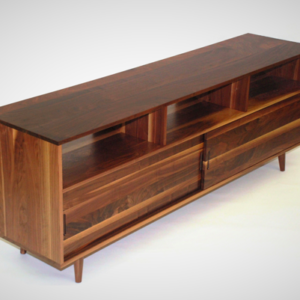I want to make a version of the sideboard in the attached picture. I’ll make this out of 4/4 walnut lumber – not plywood. I’ve never made a piece like this and there are a couple details I need advice on.
First is the joinery at the corners. I know dovetails are an option, but I want to avoid the visible joinery, which rules out regular and half-blind dovetails. I have a Festool Domino so I’m guessing that is the way to go. Is there another method that would work better that I’m missing?
Second question is about the sliding doors and how these are inserted. Is the best way to cut my tongues and grooves and then put the doors in while I’m assembling? That way the doors will be “captured” and will slide back and forth but impossible to remove.
Third issue is the back. I was planning on using walnut plywood for this to prevent racking and hold down costs.
Thanks in advance for help with these questions and any other advice.















Replies
1. If you have a domino, yes that's the way to go.
2. For the sliding doors, you should cut the top groove deep enough to push the doors up and slide them over the bottom shelf to drop into the groove. They should be removable. Do a search for sliding doors on this site. There's an article from 10/2004 and, I'm sure, other projects have them.
3. Yes, I think the hardwood plywood is a good choice for the back. Shiplap boards are more traditional, but this is a contemporary piece, so yeah, go with the plywood.
All of the joinery methods you mention are good. You could also use dowels or mortise and tenon. However, since you have the domino, that is probably the way to go.
The sliding doors, as you know, are "captured" in grooves top and bottom. In order to make them removable, the top groove is made extra deep so that the door can slide up into it far enough to clear the edges of the bottom groove and then drop down into the bottom groove. Removal is the reverse.
I found long ago that the bottom groove will, in time, collect dust, dirt, and gunk, and the doors will become sticky and difficult to slide. Based on this, I found that it works better to put a hardwood "rail" in the bottom shelf of the cabinet and a groove in the bottom of the door that will ride on the "rail". The "rail" should protrude up from the shelf surface by about 1/4-3/8". You will find that the "rail" is a bit of a nuisance because of the slight obstruction it makes at the front edge of the shelf. But, you will also find that the sliding doors will work better and longer without irritating sticking.
A 1/4"-3/9" plywood back would work just fine. The usual way is to install it snugly into rabbets so that it is flush with the cabinet edges.
Since you have never built something like this before, make double sure the walnut is dried, acclimated, and properly dimensioned before you start the assembly. Also agree with the joinery & sliding door advice. Good luck!
Great advice! Also found the article mentioned. Thanks to all.
OK I’ll say it - if you screwed the sides from the bottom you would never know the difference. Dominoes etc will help with alignment.
I can’t believe I said it.
I'll go along with th others above. Make sure you can remove the doors. It's easy enough.
And please do a better job of choosing boards and gluing panels. Someone did a crappy job on the one in the picture. Some hate sapwood in a walnut piece, others hate it. But when it's right on a glue line it really jumps out. You can do much better. And use wider stock if you can.
If you use the groove and rabbet system for the sliders you can put the entire rabbet on the back of the door to give yourself a clean look on the face of the cabinet.
This forum post is now archived. Commenting has been disabled